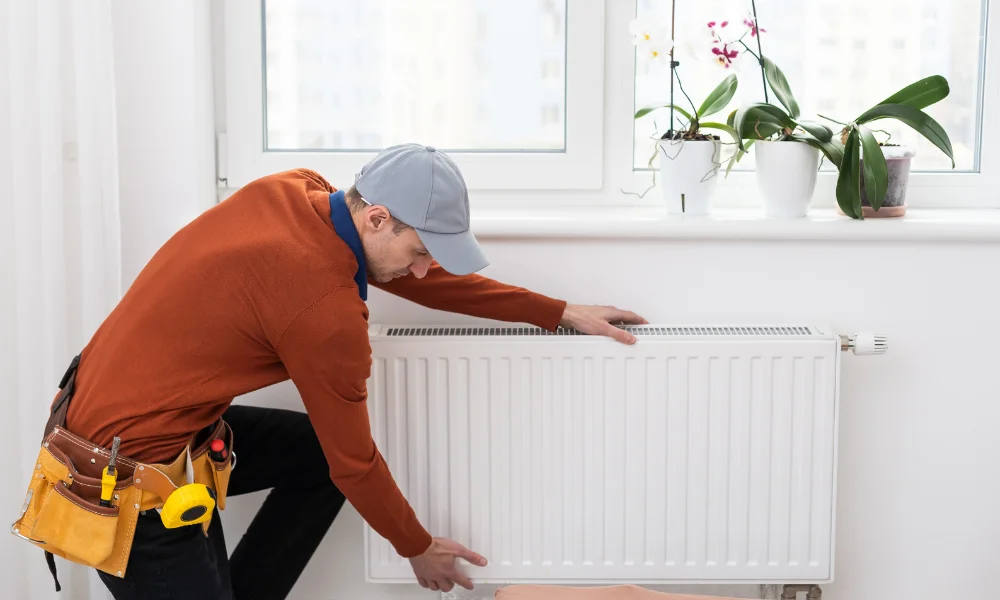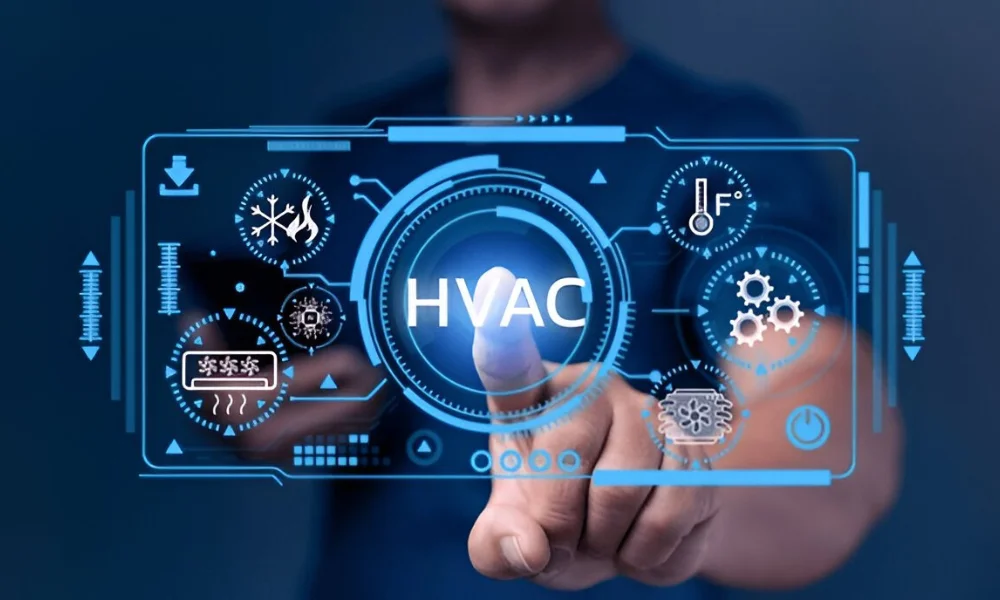Heating, Ventilation, Air Conditioning, and Refrigeration (HVAC&R) systems
Deploying an energy-efficient heating, ventilation, air conditioning, and refrigeration (HVAC&R) systems for commercial and industrial buildings requires a combination of strategic methodologies and practical implementation techniques considering several factors such as building size, function, occupancy, usage, budget, climate, energy efficiency goals, and other sustainability goals. Durrel specialize in adopting a comprehensive approach, integrating various methodologies and practices into HVAC&R design process and implementing them effectively at the site. We assure to offer a highly energy-efficient systems that reduce operational costs, minimize environmental impact, and enhance occupant comfort and productivity.


Durrel is revolutionizing HVAC&R Asset Performance Management by combining cutting-edge technology with decades of industry expertise to help businesses achieve unmatched efficiency and reliability in their HVAC&R systems. With our advanced predictive analytics, real-time monitoring, and data-driven insights, we empower companies to optimize asset performance, reduce downtime, and significantly cut maintenance costs. Durrel’s intuitive solution offers seamless integration, allowing you to track equipment health, predict potential failures before they happen, and extend the lifecycle of your HVAC&R assets. Our tailored solutions not only improve operational efficiency but also enhance energy savings, ensuring a sustainable and cost-effective approach to building management. Trust Durrel to take your HVAC&R operations to the next level—where performance meets precision, and every asset reaches its full potential.
DURREL facilitates deployment of solutions aimed at energy conservation / consumption optimization at large and meticulous selection of unit level energy efficient products
- IoT enabled monitoring equipments and Smart meters
- AI enabled Control panels
- VFD and HVAC performance enhancer
- Heating, Ventilation, Air Conditioning and Refrigeration Solutions
- HVLS and BLDC fans
- Skylights and Lighting control systems
- Home and plant automation
- Heat resistive paint
- Energy efficient motors
- Turbo ventilator
- Sealing and insulation
- Innovative fenestration systems
- and other green building products
Holistic Approach to Data Driven Management
Durrel deploys advanced software tools for energy modeling and simulation to predict the performance of different HVAC&R system configurations under varying conditions. This helps in identifying the most energy-efficient design before implementation and enables integrated approach that considers the interactions between building envelope, HVAC&R systems, and other building systems such as lighting and controls. This ensures that the HVAC&R system is fine-tuned to work synergistically with other building components to minimize energy consumption.

Avoiding over-sizing or under-sizing HVAC&R equipment by conducting detailed load calculations based on factors such as building orientation, occupancy, internal heat gains, and climate data ensures best performance and energy efficiency. Also prioritising the choice of high-efficiency HVAC&R equipment that meets or exceeds industry standards such as ENERGY STAR ratings or LEED certification requirements including energy-efficient chillers, boilers, heat pumps, air handlers, ventilation systems and using variable speed drives in HVAC&R equipment such as pumps, fans, and compressors to match system output with actual demand allows for precise control and modulation of equipment speed, resulting in significant energy savings. Integrating energy recovery systems such as heat exchangers or heat pumps to capture and reuse waste heat or coolness from exhaust air streams reduces the need for additional heating or cooling energy and improves overall system efficiency.
Avoiding over-sizing or under-sizing HVAC&R equipment by conducting detailed load calculations based on factors such as building orientation, occupancy, internal heat gains, and climate data ensures best performance and energy efficiency. Also prioritising the choice of high-efficiency HVAC&R equipment that meets or exceeds industry standards such as ENERGY STAR ratings or LEED certification requirements including energy-efficient chillers, boilers, heat pumps, air handlers, ventilation systems and using variable speed drives in HVAC&R equipment such as pumps, fans, and compressors to match system output with actual demand allows for precise control and modulation of equipment speed, resulting in significant energy savings. Integrating energy recovery systems such as heat exchangers or heat pumps to capture and reuse waste heat or coolness from exhaust air streams reduces the need for additional heating or cooling energy and improves overall system efficiency.
We strategise implementing advanced control strategies centralized control and optimization, with building automation systems (BAS) that integrate HVAC&R, lighting, security, and other building systems to optimize overall system operation based on real-time conditions, occupancy schedules, weather forecasts and energy demand, using sensors and algorithms to adjust settings. This includes strategies like demand-controlled ventilation, setback temperatures during unoccupied hours, and predictive maintenance. Our solution also encompass passive design techniques focus on using building orientation, natural ventilation, shading, insulation, and thermal mass to minimize the need for mechanical heating and cooling. These strategies can complement active HVAC&R systems to improve energy efficiency.
Durrel enables setting up a comprehensive maintenance schedule to keep HVAC&R equipment clean, calibrated, and operating efficiently. Implement continuous monitoring and data analytics to find performance deviations and potential energy-saving opportunities in real-time. We frequently conduct education training programs for building occupants about energy-saving practices and encourage their participation in energy conservation efforts. Simple actions such as turning off lights and adjusting thermostat settings can contribute to significant energy savings over time.
Technical Recommendations
Durrel engineers’ expertise in recommendation, selection, system integration and deployment strategies for the following
Heating System
Heat Source (furnaces, boilers, or heat pumps), Fuel Type (Natural gas, electricity, oil, or renewable energy sources), deploying high-efficiency equipments to minimize energy consumption, Distribution schematics (Ductwork, radiant heating, or baseboard heaters for distributing heat effectively throughout the building) and developing zoning systems to control heating in different areas independently for increased comfort and energy savings.

Ventilation System
Here the recommendations include determining the required air changes per hour (ACH) to maintain indoor air quality, Air Filtration types to remove pollutants, allergens, and particulate matter from the incoming air, incorporating heat recovery ventilation systems to capture and reuse heat from exhaust air, improving energy efficiency, ensuring proper humidity levels for comfort and health, especially in humid or arid climates.
Air Conditioning System
Periodically performing the Cooling Load Calculation for the building based on factors like size, orientation, insulation, and occupancy, Selecting the Cooling Equipment (central air conditioning units, ductless mini-split systems, or rooftop units based on the building's requirements), Using environmentally friendly refrigerants with low global warming potential (GWP) and ozone depletion potential (ODP), Opting for high-efficiency equipment and implementing energy-saving features like variable-speed compressors and fans and designing the Air Distribution Network comprising ductwork or air handlers to deliver conditioned air evenly throughout the building.
Refrigeration System
Sizing the refrigeration system to meet the specific cooling capacity requirements of refrigerated spaces such as walk-in coolers, freezers, or refrigerated display cases, ensuring precise temperature control to preserve the quality and safety of perishable goods, Implementing defrost cycles or systems to prevent ice buildup on evaporator coils and maintain efficiency and recommendation of energy-efficient compressors, condensers, and evaporators to minimize operating costs.
Controls and Automation
We specialize in deploying programmable or smart thermostats and sensors to monitor and regulate temperature, humidity, and air quality. We specialise in integrating HVAC&R systems with a centralized Building Management System (BMS) for remote monitoring, control, and optimization of equipment operation, Implementing Fault Detection and Diagnostics (FDD) algorithms to identify and troubleshoot equipment malfunctions or performance issues proactively.
Types of HVAC&R Systems
- Conventional Systems
- Variable Air Volume (VAV) Systems
- Constant Air Volume (CAV) Systems
- Heat Pump Systems
- Radiant Heating and Cooling Systems
- District Heating and Cooling Systems
- Energy Recovery Ventilation (ERV) Systems
- High-Performance HVAC&R Systems

Reference Standards and Guidelines Complying to Green Building Protocols
- Certification and Design for LEED / IGBC / GRIHA / ISO 50001 family / ISO 14001 family / BREEAM / BEE ECBC, MNRE, NGBS, NEERI, IEP, GEM and others
- World Green Building Council (WGBC), NECB, ASHRAE and the World Business Council for Sustainable Development (WBCSD) norms



